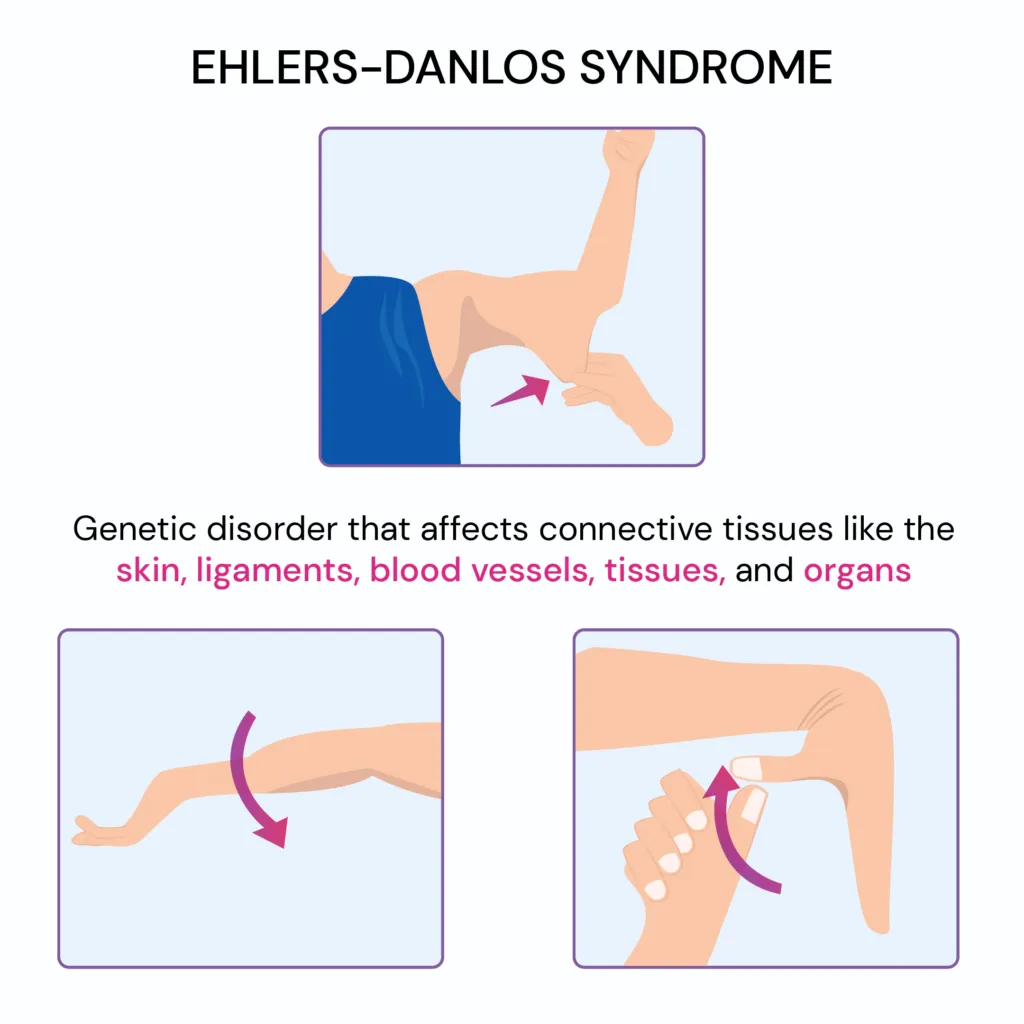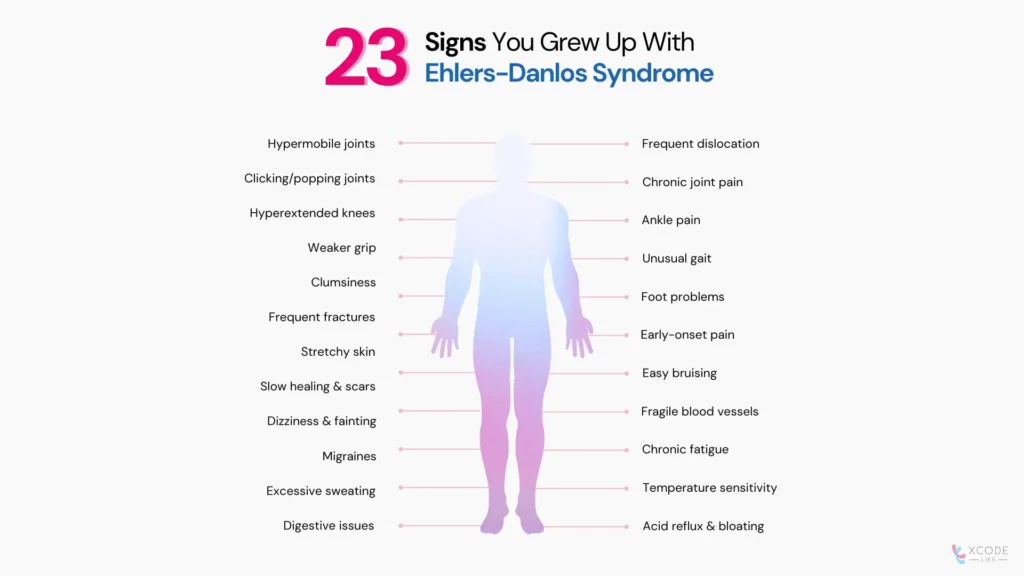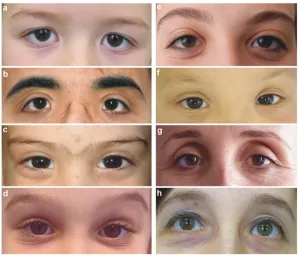Key Takeaways
Ehlers-Danlos Syndrome (EDS) often goes undiagnosed or misdiagnosed because its signs—like hypermobility, chronic pain, frequent injuries, and fatigue—can resemble other common conditions. Recognizing key indicators like joint hyperflexibility, recurrent dislocations, and digestive problems can help achieve an accurate diagnosis. Early and accurate identification of EDS enables appropriate management strategies such as physical therapy, dietary adjustments, pain management, and lifestyle modifications to improve quality of life. Always consult with a healthcare professional familiar with EDS for comprehensive evaluation and personalized treatment.
What Is Ehlers-Danlos Syndrome?
Ehler-Danlos syndrome is a group of rare inherited disorders that affect the body’s connective tissues, especially the skin, joints, and blood vessels.
Connective tissues are made up of proteins and other substances that provide them with elasticity.
In people with Ehler-Danlos syndrome, the strength of collagen is affected.
Though people with Ehler-Danlos syndrome are born with the condition, it may take years before it gets diagnosed.

23 Signs You Grew Up With Ehlers-Danlos Syndrome
Joint & Musculoskeletal Symptoms
- Hypermobile joints (double-jointed): Excessive joint mobility allows for unusually flexible movement, a hallmark of EDS.
- Frequent joint dislocations: Recurrent dislocations occur due to weakened connective tissue supporting the joints.
- Clicking or popping joints: Audible clicks or pops during movement are common because of joint instability.
- Chronic joint pain and instability: Persistent pain and unstable joints hinder everyday activities and physical performance.
- Hyperextended knees: Knees that extend beyond the normal range can lead to discomfort and further instability.
- Growing pain in the ankles: Structural instability during growth spurts often results in significant ankle discomfort.
- Difficulty with grip strength (holding a pen, opening jars): Reduced grip strength is a frequent challenge, leading to difficulty with fine motor tasks.
- Running with a different gait than others: Altered biomechanics and compensatory movements create a distinct, often inefficient running style.
- Clumsiness: Frequent clumsiness may result from joint instability, leading to uncoordinated movements and minor injuries.
- Frequent foot problems: Chronic foot pain and discomfort can arise from ligament laxity and altered foot biomechanics.
- Increased frequency of fractures: Fragile bones, due to compromised connective tissue, lead to a higher risk of fractures.
- Chronic pain at a young age: Early-onset, persistent pain is common and can significantly impact quality of life.
Skin & Wound Healing Issues
- Soft, stretchy skin: Abnormally elastic skin is a classic sign of EDS, reflecting underlying collagen differences.
- Easy bruising: Fragile blood vessels cause bruises to appear easily, even with minimal trauma.
- Slow wound healing and excessive scarring: Impaired collagen function often leads to delayed healing and prominent scars.
- Fragile blood vessels: Reduced structural integrity of vessels makes them prone to injury and bleeding.
Nervous System & Autonomic Symptoms
- Dizziness and fainting spells (POTS symptoms): Autonomic dysregulation in EDS can cause episodes of dizziness or fainting, often linked to POTS.
- Chronic fatigue: Persistent tiredness is common due to the extra effort required to stabilize joints and manage pain.
- Migraine headaches: Frequent migraines may result from vascular instability and altered neurological signaling.
- Sensitivity to temperature changes: Abnormal sensory responses can make temperature fluctuations more uncomfortable.
- Excessive sweating: Due to the improper functioning of the autonomous nervous system, temperature dysregulation may occur, leading to excessive sweating.
Digestive & Other Symptoms
- Acid reflux and bloating: Digestive tract involvement in EDS can lead to symptoms such as acid reflux and abdominal bloating.
- Nausea, constipation, or diarrhea: Altered connective tissue in the gut may cause various gastrointestinal issues.
Expert Opinion: Dr. Grubb On Signs Of Ehlers-Danlos Syndrome
Dr. Grubb, a cardiologist who specializes in autonomic research and disorders, specified some signs of EDS in his speech at the Departments of Medicine and Pediatrics Health Science campus, Ohio.
- Hypermobility - a key sign
- Cognitive impairment
- 78% of those with asymptomatic hypermobility* had abnormal autonomic test results**
- Tend to get sick earlier in life
- Some EDS patients can get extreme scars
- Increased prevalence of conditions like autism spectrum disorder and Asperger's syndrome
*Asymptomatic hypermobility: A condition where a person's joints can move more than usual (are extra flexible), but they don't experience any pain or problems because of it.
**Autonomic test results: The outcomes from medical tests that check how well the body's automatic systems—like heart rate, blood pressure, and digestion—work.

Types of Ehlers-Danlos Syndrome
There are 13 types of Ehler-Danlos syndromes (EDS), most of which are rare.
Hypermobile EDS (hEDS) is the most common type of Ehler-Danlos syndrome.
Some symptoms of hEDS are:
- Hypermobility of joints
- Unstable joints that tend to dislocate easily
- Clicking and pain in the joints
- Easy skin bruising
- Digestive problems like heartburn
- Dizziness and increased heart rate after standing up
- Urinary incontinence
There are no diagnostic tests for hEDS.
Usually, the diagnosis is based on the individual’s history, symptoms, and physical examination.
Other relatively common types of EDS are classical, vascular, and kyphoscoliotic EDS.
Is Elhers-Danlos Syndrome Genetic?
Ehlers-Danlos syndrome is a genetic condition. Over 20 genes have been found to be associated with EDS.
A few genes that have been associated with Ehler-Danlos syndrome are:
- COL1A1
- COL1A2
- COL3A1
- COL5A2
These genes provide instructions for making different types of collagen.
Changes (variants) in these genes may disrupt the production or processing of collagen, resulting in weak bones, skin, or other parts of the body.
This gives rise to the characteristic features of Ehler-Danlos syndrome.
Each type of EDS is caused by variants in different collagen genes.
- Variants in the COL5A1, COL5A2, and sometimes in the COL1A1 genes cause the classical type EDS
- Variants in the TNXB gene cause the classical EDS and a few cases of hypermobile type
- Variants in the COL1A2 gene cause cardiovascular EDS and some cases of arthrochalasia
Explore your ancestry test raw DNA data
Certain gene changes can put you at higher risk for developing many chronic conditions like diabetes, hypertension, and even scoliosis. Learning about your genetic risks can help plan prevention strategies even before the symptoms appear.
Please note: Xcode Life does not test for Ehlers-Danlos Syndrome
Diagnosing Ehlers-Danlos Syndrome
Ehlers-Danlos syndrome (EDS) is diagnosed through a combination of clinical evaluation, genetic testing (for specific subtypes), and exclusion of other connective tissue disorders.
Clinical Criteria and Assessment
- Beighton score: A 9-point system assessing joint hypermobility (e.g., ability to bend the thumb to the forearm, hyperextend knees/elbows). A score ≥5/9 in adults (≥6/9 in children) indicates generalized joint hypermobility.
- Skin evaluation: Features like hyperextensibility, velvety texture, or "cigarette paper" scarring are assessed.
- Family history: Many EDS subtypes (e.g., classical, vascular) follow autosomal dominant inheritance patterns.
- Associated symptoms: Chronic joint pain, dislocations, tissue fragility, and complications like kyphosis or aortic aneurysms are evaluated.
Genetic Testing
- Available for select subtypes:
- Classical EDS: COL5A1 or COL5A2 mutations (collagen V defects)
- Vascular EDS: COL3A1 mutations (collagen III defects)
- Classical-like EDS: TNXB gene mutations
The Diagnosis Conundrum: EDS vs. Marfan vs. Fibromyalgia
EDS, Marfan Syndrome, Fibromyalgia, and Joint Hypermobility Syndrome share overlapping symptoms like joint hypermobility and chronic pain.
However, EDS is marked by fragile connective tissue, skin hyperextensibility, and frequent dislocations, while Marfan Syndrome typically includes tall stature and cardiovascular issues.
Fibromyalgia focuses on widespread pain without connective tissue abnormalities, and Joint Hypermobility Syndrome lacks the systemic features seen in EDS.
Accurate diagnosis relies on detailed clinical evaluation and genetic testing.
Treatment for Ehlers-Danlos Syndrome
There is no cure for Ehler-Danlos syndrome.
Treatment is aimed at managing the symptoms and preventing further complications.
People with EDS usually have many healthcare professionals supporting their journey with the disease.
The healthcare team for EDS usually includes an occupational therapist, physiotherapist, and counselors.
Genetic counseling may help people understand their condition, how it is inherited, and the risk of passing it to their children.
Holistic Approach To EDS Management*
Diet and Supplements
- Anti-inflammatory focus: Prioritize whole foods like leafy greens, antioxidant-rich fruits, and omega-3 sources (salmon, walnuts) to reduce inflammation.
- Nutrient support: Address common deficiencies in vitamin D (bone health), B12 (cognitive function), and iron (fatigue) through fortified foods or supplements under medical guidance.
- Gut health: Include prebiotics (garlic, bananas) and probiotics (yogurt, kefir) to improve digestion and reduce gastrointestinal symptoms1.
- Individualization: Tailor diets to comorbidities (e.g., gluten-free for celiac disease, low-carb for diabetes).
Environment
- Ergonomics: Use supportive seating, joint braces, and adaptive tools to minimize strain on hypermobile joints.
- Sensory considerations: Reduce triggers for mast cell activation (MCAS) by avoiding allergens and fragrances. Air purifiers can also help improve indoor air quality.
- Compression garments: Can help improve blood flow and reduce symptoms like dizziness or fatigue
Workout And Mindfulness
- Low-impact exercise: Focus on swimming, Pilates, or resistance training to strengthen muscles without stressing joints.
- Timing: Avoid exercise for at least an hour post-meal to prevent autonomic dysfunction flare-ups.
- Physical therapy: Customized programs to stabilize joints and improve proprioception.
- Stress reduction: Meditation and breathing exercises can alleviate anxiety and chronic pain.
- Cognitive-behavioral strategies: Address the emotional toll of EDS through guided therapy or journaling.
*For informational purposes only. These strategies may work well for some than others. It is not advisable to start any supplements without consulting a qualified medical practitioner. A healthcare professional can provide guidance based on your unique circumstances and health profile. Always prioritize professional guidance when considering lifestyle and environmental changes.
Can EDS And Autism Co-occur?
EDS and autism demonstrate significant clinical and genetic overlaps, with emerging research highlighting shared mechanisms and comorbidities.
Both conditions may share genetic mutations affecting connective tissue and neurological development.
For instance, genes involved in collagen production (implicated in EDS) may also influence brain development, potentially contributing to autism traits.
These shared genetic factors may explain why individuals with EDS are more likely to exhibit autistic traits or receive an ASD diagnosis.
Overlapping Symptoms
Symptomatically, both conditions share features such as:
- Sensory sensitivities: Individuals with EDS and autism often experience heightened sensitivity to light, sound, or touch.
- Motor coordination challenges: Joint hypermobility in EDS can lead to proprioceptive issues**, similar to motor difficulties seen in autism.
- Gastrointestinal problems: Digestive issues like irritable bowel syndrome are common in both conditions
**Proprioception is also called kinesthesia. It is the body's awareness of its position and movement in space, which is crucial for coordination and balance.
Overlapping Comorbidities
- ADHD: Attention-deficit/hyperactivity disorder (ADHD) is frequently reported alongside both EDS and autism. Shared neurological pathways may explain this overlap.
- Anxiety: Anxiety is common in both groups. In EDS, it’s often linked to chronic pain or autonomic dysfunction. In autism, it can stem from sensory overload or social stress.
- Fibromyalgia: Chronic pain and fatigue in fibromyalgia mimic symptoms in EDS and autism, making diagnosis tricky. These conditions all involve heightened sensory sensitivity and nervous system dysregulation.
Mast Cell Activation Syndrome (MCAS): MCAS, more common in EDS, can cause flushing, GI issues, and chemical sensitivities. Some researchers are exploring whether similar immune responses occur in autism too.
FAQs: Signs Of Ehlers-danlos Syndrome
What Are The Strange Symptoms Of EDS?
EDS has some unusual symptoms that may not immediately suggest a connective tissue disorder. These include
- stretchy or velvety skin
- easy bruising
- frequent joint dislocations
- chronic pain
- fragile blood vessels
Some people also experience digestive issues, fatigue, or even dizziness when standing up due to related conditions like POTS (Postural Orthostatic Tachycardia Syndrome).
What’s The Life Expectancy Of Someone With EDS?
For most types of EDS, especially hypermobile and classical types, life expectancy is normal.
However, the quality of life can be impacted by chronic pain or joint instability.
In vascular EDS (vEDS), life expectancy can be reduced due to risks like arterial or organ rupture.
Can EDS Worsen With Age?
Yes, EDS symptoms can evolve over time.
Joint hypermobility may decrease with age, but chronic pain, fatigue, joint instability, and early-onset osteoarthritis often increase.
Some people also develop complications like autonomic dysfunction or digestive issues later in life.
What Are The Red Flags For Ehlers-Danlos Syndrome?
The main red flag for EDS is hypermobile joints, which move beyond the normal range.
Other signs can be a family history of connective tissue disorders, delayed wound healing, and gum fragility.
Early recognition is key, as EDS can affect multiple body systems.
How Does Ehlers-Danlos Affect Hair?
EDS does not directly affect hair growth or hair loss.
However, nutritional deficiencies, common in some types of EDS due to digestive issues, may lead to hair thinning or brittleness.
Collagen supplements are sometimes recommended to support overall connective tissue health, but their effect on hair growth is not fully established.
What Are The Facial Features Of EDS?
Some people with EDS may have subtle facial features that include thin, translucent skin, a narrow nose, or high cheekbones. In certain types, like vascular EDS, skin can appear paper-thin, especially around the eyes and nose. However, facial features can vary widely, and not all individuals with EDS will exhibit these traits.
Does EDS Affect Breasts?
Yes, EDS can affect breast tissue. Those with hypermobile EDS experience pain from large breasts. Some studies also report rare cases of calcifications (tiny spots of calcium) in the breast tissue.
Since people with EDS have more delicate tissues, everyday activities can cause small injuries (microtrauma) to the breast tissue.
These tiny injuries can lead to a healing process that sometimes leaves behind calcium deposits.
What Can Be Mistaken For Ehlers-Danlos?
EDS can be mistaken for other conditions that affect connective tissue, such as Marfan syndrome, Loeys-Dietz syndrome, or joint hypermobility syndrome.
Due to overlapping symptoms like chronic pain and fatigue, it may also be misdiagnosed as fibromyalgia.
Proper genetic testing and clinical evaluation by a specialist are crucial for accurate diagnosis.
Do People With Ehlers Danlos Look Younger?
Some individuals with Ehlers-Danlos syndrome (EDS) may appear younger due to specific skin characteristics associated with the condition.
People with EDS often have soft, velvety, and stretchy skin, which can give a youthful appearance.
However, this is not universally true for all individuals with EDS, as the condition can also lead to skin fragility, bruising, scarring, and other visible features such as "cigarette paper" scars or sagging skin in certain types of EDS like dermatosparaxis.
Is Ehlers Danlos Syndrome A Chronic Illness?
Yes, Ehlers-Danlos syndrome (EDS) is considered a chronic illness. EDS symptoms are lifelong and require ongoing management to prevent complications and improve quality of life.
Chronic pain is a common feature of EDS, affecting approximately 90% of patients, which further supports its classification as a chronic condition
Expert-recommended pick

Ehlers Danlos Syndrome & The Eyes
Summary: 23 Signs You Grew Up With Ehlers-Danlos Syndrome
- Ehler-Danlos syndrome (EDS) is a group of rare inherited disorders that affect the body’s connective tissues.
- People with Ehler-Danlos syndrome are born with it, but their symptoms may take years or, sometimes, decades to show.
- There are around 13 different types of Ehler-Danlos syndrome, and hypermobility EDS (hEDS) is the most common type.
- Ehler-Danlos syndrome is a genetic condition; to date, over 20 genes, including COL1A1 and COL1A2, have been associated with the condition.
- Most people with Ehler-Danlos are unaware of their condition as they are unable to spot signs like easy skin bruising and joint dislocation.
References
- https://themighty.com/topic/ehlers-danlos-syndrome/signs-growing-up-with-ehlers-danlos-syndrome-eds/
- https://www.yahoo.com/news/22-signs-grew-hypermobility-002742611.html
- https://www.nhs.uk/conditions/ehlers-danlos-syndromes/
- https://www.actifypt.com/post/7-symptoms-of-ehlers-danlos-syndrome-that-google-wone28099t-tell-you-about
- https://blog.cincinnatichildrens.org/rare-and-complex-conditions/ehlers-danlos-syndrome-the-lengthy-road-to-diagnosis/
- https://www.ehlers-danlos.com/what-is-eds/




